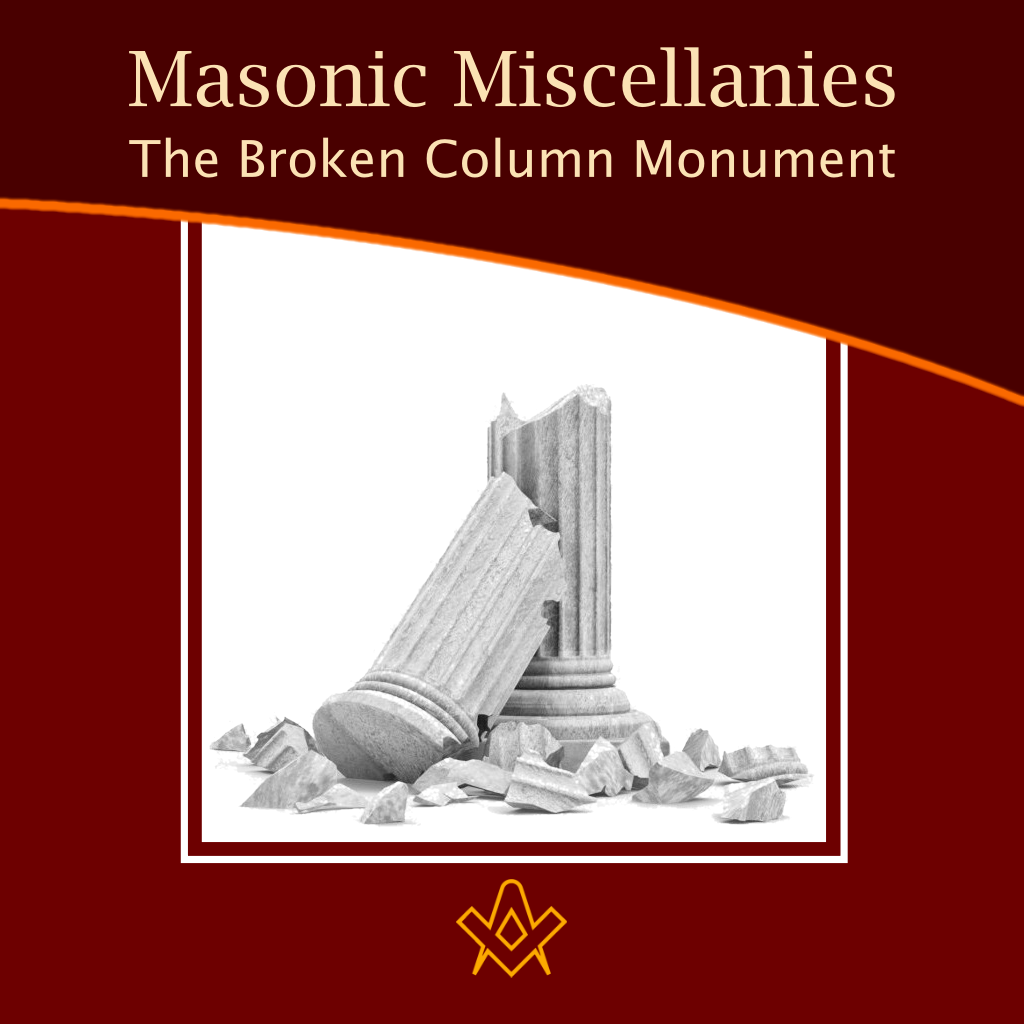“The body of our Grand Master was buried three times: first, in the rubbish of the Temple; secondly, on the brow of a hill west of Mount Moriah; and, thirdly and lastly, as near the “Sanctum Sanctorum, or Holy of Holies,” of King Solomon’s Temple, as the Jewish law would permit; and Masonic tradition informs us that there was erected to his memory a Masonic monument, consisting of “a beautiful virgin, weeping over a broken column; before her was a book open; in her right hand a sprig of acacia, in her left an urn; behind her stands Time, unfolding and counting the, ringlets of her hair.”
The beautiful virgin weeping over the broken column denotes the unfinished state of the Temple, likewise the untimely death of our Grand Master, Hiram Abiff; the book open before her, that his virtues lay on perpetual record; the sprig of acacia in her right hand, the divinity of the body; the urn in her left, that his ashes were therein safely deposited, under the “Sanctum Sanctorum, or Holy of Holies,” of King Solomon’s Temple.
Time, unfolding the ringlets of her hair, denoted that time, patience, and perseverance accomplish all things.”
– Duncan’s Ritual [1866]
The Broken Column
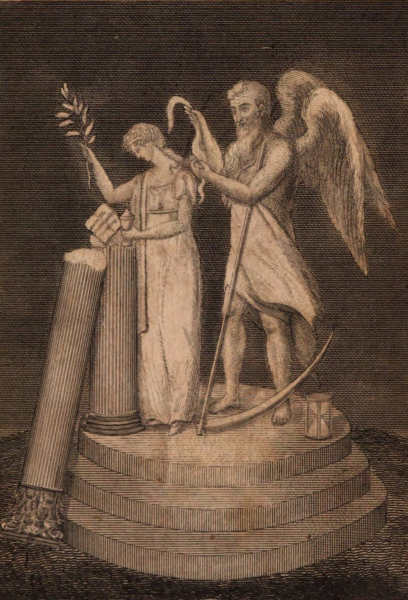
Engraving by Amos Doolittle. “The True Masonic Chart” by Jeremy Cross, 1819
IMAGE LINKED: wikimedia Attribution 4.0 International (CC BY 4.0)
From: Short Talk Bulletin – Vol. 34, February 1956, No. 2 – Author Unknown
The story of the broken column was first illustrated by Amos Doolittle in the “True Masonic Chart” by Jeremy Cross, published in 1819.
Many of Freemasonry’s symbols are of extreme antiquity and deserve the reverence which we give to that which has had sufficient vitality to live long in the minds of men. For instance, the square, the point within a circle, the apron, circumambulation, the Altar have been used not only in Freemasonry but in systems of ethics, philosophy and religions without number.
Other symbols in the Masonic system are more recent. Perhaps they are not the less important for that, even without the sanctity of age which surrounds many others.
Among the newer symbols is that usually referred to as the broken column. A marble monument is respectably ancient – the broken column seems a more recent addition.
There seems to be no doubt that the first pictured broken column appeared in Jeremy Cross’s “True Masonic Chart”, published in 1819, and that the illustration was the work of Amos Doolittle, an engraver, of Connecticut.
Amos Doolittle was one of the earliest American copperplate engravers. He spent his life in and around New Haven, Connecticut.
Initially apprenticed to a jeweler and silversmith, he taught himself engraving and became a prolific producer of historical and satirical engravings, bookplates, portraits and biblical illustrations. His first major project was a famous series of four engravings after Ralph Earle, portraying the Battles of Lexington and Concord.
These were among the very earliest historical prints done in America, preceded by only two others.
Doolittle had himself been present at these events as a Connecticut militia-man, and the prints are noteworthy for the lack of romanticization found in later prints of the subject.
He freely expressed his patriotism in his satires, however, stating that such prints;
“will have a tendency to inspire our countrymen with confidence in themselves, and eradicate any terrors that they feel as respects the enemy they have to combat.”
Doolittle trained at least one of his sons as an engraver, as well as James Wilson (1763-1855), who went on to become the first globe maker in America.
The papers of Doolittle and his family are in the archives of Yale University, which also owns a number of his engravings.

Amos Doolittle (1754-1832) – Engraving by Samuel Perkins Gilmore, 1868-1948 – Kentucky Digital Library, Samuel Perkins Gilmore prints, 1718-1935,
IMAGE LINKED: wikimedia Attribution 4.0 International (CC BY 4.0)
That Jeremy Cross “invented” or “designed” the emblem is open to argument. But there is legitimate room for argument over many inventions.
Who invented printing from movable type? We give the credit to Gutenberg, but there are other claimants, among them the Chinese at an earlier date.
Who invented the airplane? The Wrights first flew a “mechanical bird” but a thousand inventors have added to, altered, changed their original design, until the very principle which first enabled the Wrights to fly, the “warping wing”, is now discarded and never used.
Therefore, if authorities argue and contend about the marble monument and broken column it is not to make objection or take credit from Jeremy Cross; the thought is that almost any invention or discovery is improved, changed, added to and perfected by many men.
Edison is credited with the first incandescent lamp, but there is small kinship between his carbon filament and a modern tungsten filament bulb.
Roentgen was first to bring the “x-ray” to public notice-the discoverer would not know what a modern physician’s x-ray apparatus was if he saw it!
In the library of the Grand Lodge of Iowa in Cedar Rapids, is a book published in 1784; “A Brief History of Free masonry” by Thomas Johnson, at that time the Tiler of the Grand Lodge of England (the “Moderns”).
In this book the author states that he was “taken the liberty to introduce a Design for a Monument in Honor of a Great Artist.”
He then admits that there is no historical account of any such memorial but cites many precedents of “sumptuous Piles” which perpetuate the memories and preserve the merits of the historic dead, although such may have been buried in lands far from the monument or “perhaps in the depth of the Sea”.
In this somewhat fanciful and poetic description of this monument, the author mentions an urn, a laurel branch, a sun, a moon, a Bible, square and compasses, letter G. The book was first published in 1782, which seems proof that there was at that time at least the idea of a monument erected to the Master Builder.
There is little historical material upon which to draw to form any accurate conclusions. Men write of what has happened long after the happenings.
Even when faithful to their memories, these may be, and often are, inaccurate. It is with this thought in mind that a curious statement in the Masonic newspaper, published in New York seventy-five years ago, must be considered.
In the issue of May 10, 1879, a Robert B. Folger purports to give Cross’ account of his invention, or discovery, an inclusion, of the broken column into the marble monument emblem.
The account is long, rambling and at times not too clear. Abstracted, the salient parts are as follows.
Cross found or sensed what he considered a deficiency in the Third Degree which had to be filled in order to effect his purposes. He consulted a former Mayor of New Haven, who at the time was one of his most intimate friends.
Even after working together for a week, they did not hit upon any symbol which would be sufficiently simple and yet answer the purpose.
Then a Copper-plate engraver, also a brother, was called in. The number of hieroglyphics which had been this time accumulated was immense.
Some were too large, some too small, some too complicated, requiring too much explanation and many were not adapted to the subject.
Finally, the copper-plate engraver said, “Brother Cross, when great men die, they generally have a monument.” “That’s right!” cried Cross; “I never thought of that!” He visited the burying-ground in New Haven.
At last he got an idea and told his friends that he had the foundation of what he wanted. He said that while in New York City he had seen a monument in the southwest corner of Trinity Church yard erected over Commodore Lawrence, a great man who fell in battle.
It was a large marble pillar, broken off. The broken part had been taken away, but the capital was lying at the base.
He wanted that pillar for the foundation of his new emblem, but intended to bring in the other part, leaving it resting against the base.
This his friends assented to, but more was wanted. They felt that some inscription should be on the column.
After a length discussion they decided upon an open book to be placed upon the broken pillar. There should of course be some reader of the book! Hence the emblem of innocence – a beautiful virgin – who should weep over the memory of the deceased while she read of his heroic deeds from the book before her.
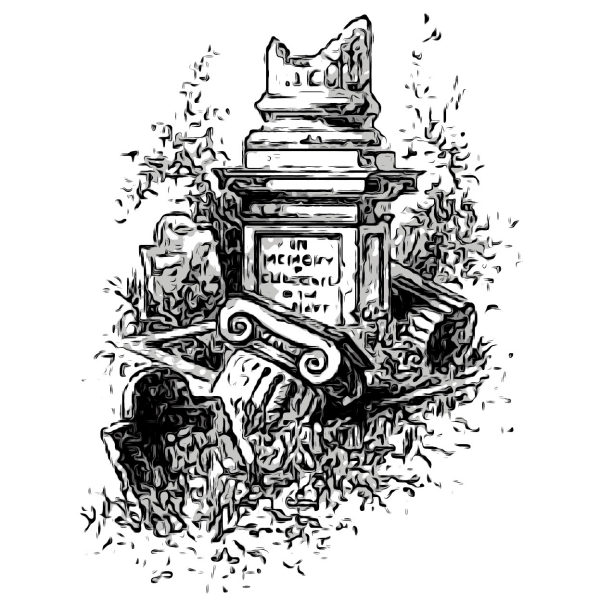
The monument erected to the memory of Commodore Lawrence was placed in the southwest corner of Trinity Churchyard in 1813, after the fight between the frigates Chesapeake and Shannon, in which battle Lawrence fell.
As described, it was a beautiful marble pillar, broken off, with a part of the capital laid at its base.
lt remained until 1844-5 at which time Trinity Church was rebuilt. When finished, the corporation of the Church took away the old and dilapidated Lawrence monument and erected a new one in a different form, placing it in the front of the yard on Broadway, at the lower entrance of the Church.
When Cross visited the new monument, he expressed great disappointment at the change, saying “it was not half as good as the one they took away!”
These claims of Cross – perhaps made for Cross – to having originated the emblem are disputed.
Oliver speaks of a monument but fails to assign an American origin. In the Barney ritual of 1817, formerly in the possession of Samuel Wilson of Vermont, there is the marble column, the beautiful virgin weeping, the open book, the sprig of acacia, the urn, and Time standing behind.
What is here lacking is the broken column. Thus it appears that the present emblem, except the broken column, was in use prior to the publication of Cross’ work (1819).
The emblem in somewhat different form is frequently found in ancient symbolism. Mackey states that with the Jews a column was often used to symbolize princes, rulers or nobles.
A broken column denoted that a pillar of the state had fallen. In Egyptian mythology, Isis is sometimes pictured weeping over the broken column which conceals the body of her husband Osiris, while behind her stands Horus or Time pouring ambrosia on her hair.
In Hasting’s “Encyclopaedia of Religion and Ethics”, Isis is said sometimes to be represented standing; in her right hand is a sistrum, in her left hand a small ewer and on her forehead is a lotus, emblem of resurrection.
In the Dionysaic Mysteries, Dionysius is represented as slain; Rhea goes in search of the body.
She finds it and causes it to be buried. She is sometimes represented as standing by a column holding in her hand a sprig of wheat, emblem of immortality; since, though it be placed in the ground and die, it springs up again into newness of life.
She was the wife of Kronus or Time, who may fittingly be represented as standing behind her.
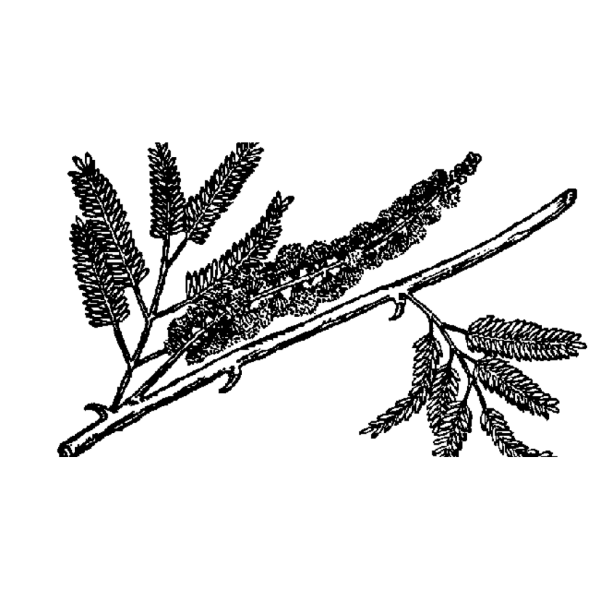
Sprig of Acacia
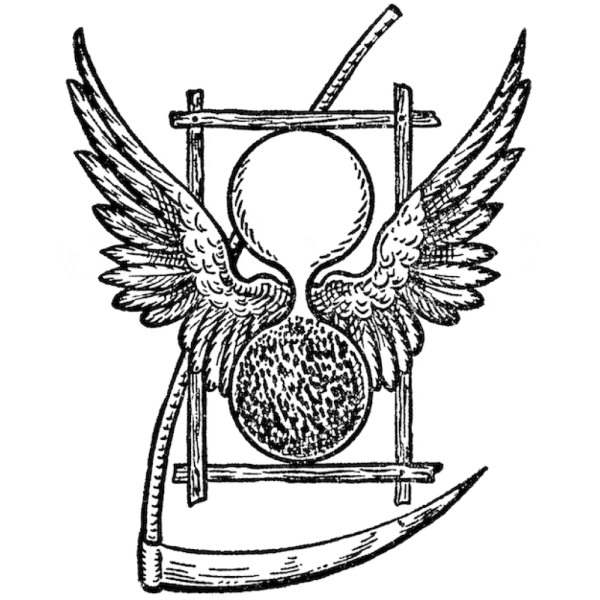
The Hourglass and Scythe
Whoever invented the emblem or symbol of the marble monument, the broken column, the beautiful virgin, the book, the urn, the acacia, Father Time counting the ringlets of hair, could not have thought through all the implications of this attempt – doubtless made in all reverence – to add to the dignity and impressiveness of the story of the Master Builder.
The urn in which “ashes were safely deposited” is pure invention. Cremation was not practiced by the Twelve Tribes; it was not the method of disposing of the dead in the land and at the time of the building of the Temple, but rather was the burning of the dead body reserved as a dreadful fate for the corpses of criminals and evil doers.
That so great a man as “the widow’s son, of the tribe of Naphtali” should have been cremated is unthinkable.
The Bible is silent on the subject; it does not mention Hiram the Builder’s death, still less the disposal of the body, but the whole tone of the Old Testament in description of funerals and mournings, make it impossible to believe that his body was burned, or that his ashes might have been preserved.
The Israelites did not embalm their dead; burial was accomplished on the day of death or, at the longest wait, on the day following.
According to the legend, the Master Builder was disinterred from the first or temporary grave and reinterred with honor.
That is indeed, a supposable happening; that his body was raised only to be cremated is wholly out of keeping with everything known of deaths, funeral ceremonies, disposal of the dead of the Israelites.
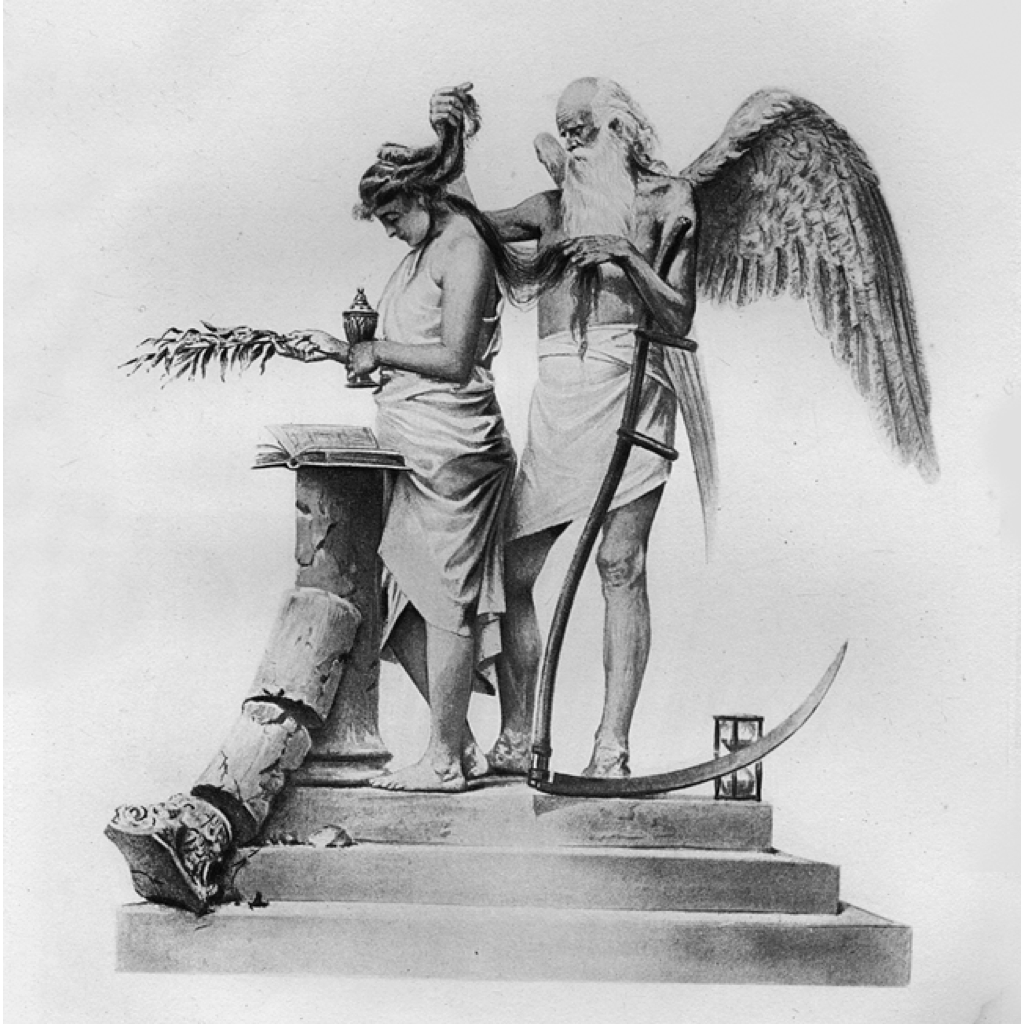
In the ritual which describes the broken column monument, before the figure of the virgin is “a book, open before her.”
Here again invention and knowledge did not go hand in hand. There were no books at the time of the building of the Temple, as moderns understand the word.
There were rolls of skins, but a bound book of leaves made of any substance-vellum, papyrus, skins-was an unknown object.
Therefore there could have been no such volume in which the virtues of the Master Builder were recorded.
No logical reason has been advanced why the woman who mourned and read in the book was a “beautiful virgin.”
No scriptural account tells of the Master Builder having wife or daughter or any female relative except his mother.
The Israelites reverenced womanhood and appreciated virginity, but they were just as reverent over mother and child.
Indeed, the bearing of children, the increase of the tribe, the desire for sons, was strong in the Twelve Tribes; why, then, the accent upon the virginity of the woman in the monument?
“Time standing behind her, unfolding and counting the ringlets of her hair” is dramatic, but also out of character for the times.
“Father Time” with his scythe is probably a descendant of the Greek Chromos, who carried a sickle or reaping hook, but the Israelites had no contact with Greece.
It may have been natural for whoever invented the marble monument emblem to conclude that Time was both a world-wide and a time immemorial symbolic figure, but it could not have been so at the era in which Solomon’s Temple was built.
It evidently did not occur to the originators of this emblem that it was historically impossible.
Yet the Israelites did not erect monuments to their dead. In the singular, the word “monument” does not occur in the Bible; as “monuments” it is mentioned once, in Isaiah 65 – “A people…which remain among the graves and lodge in the monuments.”
In the Revised Version this is translated “who sit in tombs and spend the night in secret places.”
The emphasis is apparently upon some form of worship of the dead (necromancy). The Standard Bible Dictionary says that the word “monument” in the general sense of a simple memorial does not appear in Biblical usage.
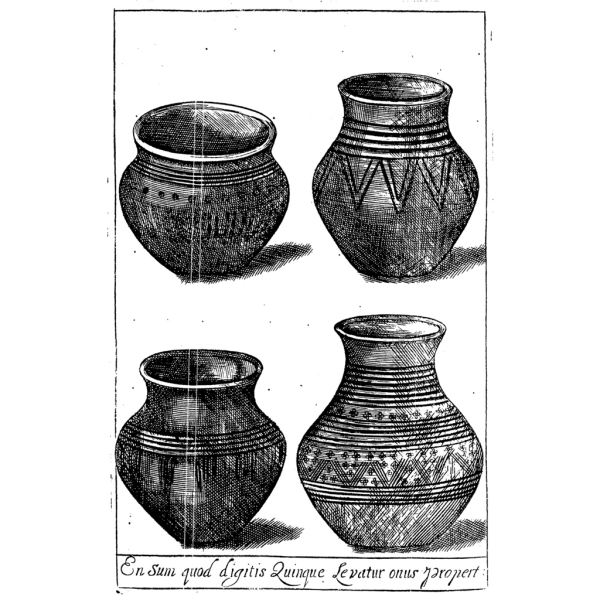
Burial Urns – “Hydriotaphia (Urn Burial)”, Thomas Browne, 1658.
Oliver Day Street in “Symbolism of the Three Degrees” says that the urn was an ancient sign of mourning, carried in funeral processions to catch the tears of those who grieved.
But the word “urn” does not occur in the Old Testament nor the New. Freemasonry is old. It came to us as a slow, gradual evolution of the thoughts, ideas, beliefs, teachings, idealism of many men through many years.
It tells a simple story-a story profound in its meaning, which therefore must be simple, as all great truths in the last analysis are simple.
The marble monument and the broken column have many parts. Many of these have the aroma of age.
Their weaving together into one symbol may be-probably is-a modernism, if that term can cover a period of nearly two hundred years, but the importance of a great life, his skill and knowledge; his untimely and pitiful death is not a modernism.
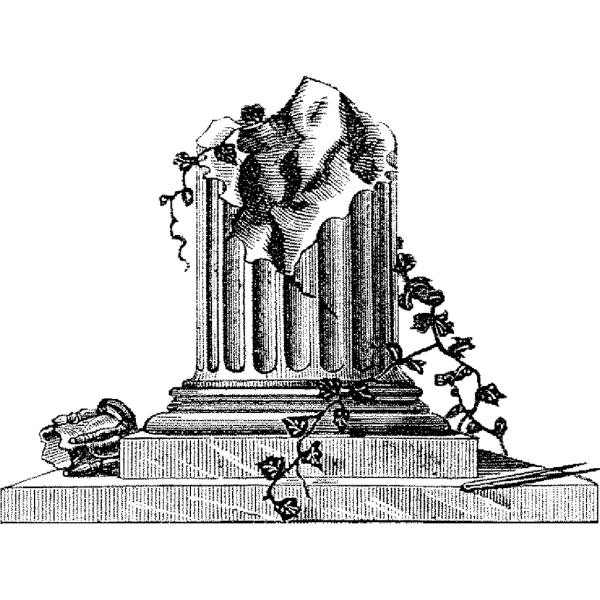
Nothing herein set forth is intended as in any way belittling one of Freemasonry’s teachings by means of ritual and picture.
These few pages are but one of many ways of trying to illuminate the truth behind a symbol, and show that, regardless of the dates of any parts of the emblem, the whole has a place in the Masonic story which has at least romance, if not too much fact, behind it.
A BRIEF BIOGRAPHY OF BROTHER JEREMY L. CROSS
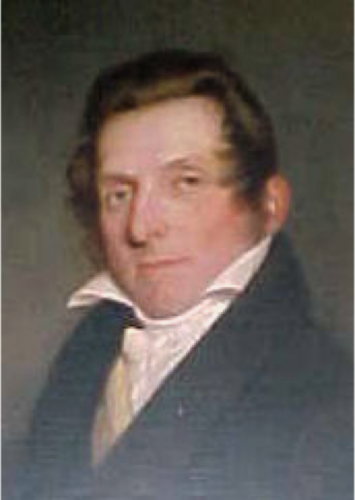
Brother Cross was a teacher of the Masonic ritual, who, during his lifetime, was extensively known, and for some time very popular. He was born June 27, 1783, at Haverhill, New Hampshire, and died at the same place in 1861.
Cross was admitted into the Masonic Order in 1808, and soon afterward became a pupil of Thomas Smith Webb, whose modifications of the Preston lectures and of the advanced Degrees were generally accepted by the Freemasons of the United States. Cross, having acquired a competent knowledge of Webb’s system began to travel and disseminate it throughout the country.
In 1819 he published “The True Masonic Chart or Hieroglyphic Monitor”, in which he borrowed liberally from the previous work of Webb. In fact, the Chart of Cross is, in nearly all its parts, a mere transcript of the Monitor of Webb, the first edition of which was published in 1797.
Webb, it is true, took the same liberty with Preston, from whose “Illustrations of Masonry” he borrowed largely. The engraving of the emblems constituted, however, an entirely new and original feature in the Hieroglyphic Chart, and, as furnishing aids to the memory, rendered the book of Cross at once very popular; so much so, indeed, that for a long time it almost altogether superseded that of Webb.
In 1820, Cross published “The Templars Chart”, which, as a monitor of the Degrees of chivalry, met with equal success. Both of these works have passed through numerous editions. Cross received the appointment of Grand Lecturer from many Grand Lodges, and travelled for many years very extensively through the United States, teaching his system of lectures to Lodges, Chapters, Councils, and Encampments.
He possessed few or no scholarly attainments, and his contributions to the Literature of Freemasonry are confined to the two compilations already cited. In his latter years he became involved in an effort to establish a Supreme Council of the Ancient and Accepted Rite.
But he soon withdrew his name, and retired to the place of his nativity, where he died at the advanced age of seventy-eight. Although Cross was not a man of any very original genius, yet a more recent writer has announced the fact that the symbol in the Third Degree, the broken column, unknown to the system of either Preston or Webb, was invented by him.
Text source: Phoenix Masonry
Recent Articles: Masonic Miscellanies
 Masonic Miscellanies - The Amulet of the Ladder Explore the cosmic significance of the Ladder in ancient Egyptian mythology through Wallis Budge's "Egyptian Magic." Discover how this profound symbol bridges the mortal and divine, encapsulating the Egyptians' fervent afterlife aspirations with a blend of myth, magic, and material culture. Dive into the celestial ascent of Osiris and mortal souls. |
 Masonic Miscellanies - Adulterine Gilds Guilds, the associations that shaped medieval European society, were more than just organizations of artisans and merchants. They played a vital role in the economic and social development of towns and cities. This exploration delves into the intriguing concept of adulterine gilds and their interconnectedness with guilds, offering insight into the significance of legal authorization and recognition in medieval Europe. |
 Masonic Miscellanies - Masonic Orb Discover the fascinating world of Masonic ball watch fobs, intricately crafted with tiny pyramids that form a cross when opened. These decorative accessories were all the rage in the late 1800s and early 1900s, and they still hold a certain allure today. Explore the different varieties and symbols found on these unique pieces that carry deep Masonic meaning. |
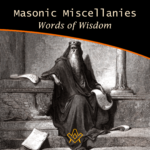 Masonic Miscellanies – Words of Wisdom Uncover timeless wisdom from King Solomon to Albert Pike in our latest Masonic Miscellanies, a treasure trove of insights for Masons. Journey through the ages and glean inspiring sayings, reflecting on their profound influence on Masonic principles. An enriching read for the enlightened. |
 Masonic Miscellanies - Symbolism of the Right Hand Unlock the enigmatic realm of Freemasonry as we delve into its age-old symbols, rituals, and philosophies. This thought-provoking exploration, drawn from Mackey's Revised Encyclopedia of Freemasonry, focuses on the iconic 'right hand' symbol - its rich history, universality, and profound significance. |
 Masonic Miscellanies - Order of the Secret Monitor Unveil the mystery of Freemasonry with 'The Order of the Secret Monitor'. Discover this lesser-known appendant order, its unique rituals, and the profound teachings it offers. Explore the bonds of friendship and brotherhood it fosters, all wrapped in an intriguing cloak of mystery. Your journey into the depths of Masonic wisdom begins here. |
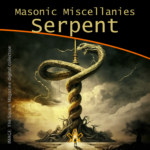 Masonic Miscellanies - The Symbol of the Serpent As a symbol, the serpent obtained a prominent place in all the ancient initiations and religions. |
 Masonic Miscellanies - The Four Veils in Royal Arch Masonry What are the four veils in Royal Arch Masonry? And what is the 'Ceremony of Passing the Veils'? Although common throughout Scotland, Ireland and the United States, it is mostly unknown in England, presently only worked in the Province of Bristol. ( and by dispensation ) |
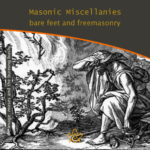 Masonic Miscellanies - Bare feet and Freemasonry A candidate for initiation into a Masonic Lodge often finds the requirements which he/she must fulfil somewhat odd. The mode of preparation often remains a puzzle, since the ritualistic explanation is not offered in full. Why are we 'slipshod' or "bare-footed" in Masonic Ritual? |
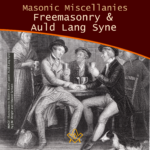 Masonic Miscellanies – Freemasonry and Auld Lang Syne Millions of people throughout the world will sing Auld Lang Syne to see out the Old Year. Few will know all the words, fewer still know what they mean, or that there is a link to Freemasonry. |
 Masonic Miscellanies - The Mosaic Pavement - why mosaic, why pavement? We are all familiar with the black and white chequered flooring of the Masonic lodge but where did it originate? There are a few theories… |
 Masonic Miscellanies – Masonic Master's Carpets Have you got a magic "Masonic Master's Carpet" in your lodge? I say 'magic' with my tongue firmly in my cheek because (as far as I know) these fabulous works of art don't bestow any mystical powers but can bestow some educational ones! However, considering their possible value today, they may magic up some interest (or funds). |
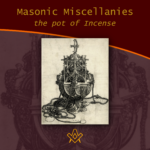 Masonic Miscellanies – The Pot of Incense Just when the pot of incense became an emblem of the third section of the Sublime Degree can not be stated with certainty. It is, apparently, an American invention or addition. But what does it symbolise? |
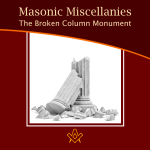 Masonic Miscellanies - The Broken Column Monument The story of the broken column was first illustrated by Amos Doolittle in the "True Masonic Chart" by Jeremy Cross, published in 1819. |
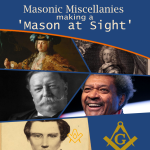 Masonic Miscellanies - Making a 'Mason at Sight' What does it mean to make a 'Mason at sight', and who was made one? |
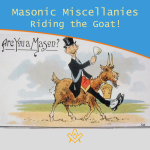 Masonic Miscellanies - Riding the Goat! Many Freemasons will have come across the phrase 'riding the goat', and will no doubt have been the butt of a joke about it (sorry, I couldn't resist!) But what does it mean and where did the phrase come from? |
 Masonic Miscellanies - What are the 'three dots'? Three dots or points in an upright triangular shape ∴ is most commonly known as the 'therefore' sign – so why is it used in Freemasonry? |
 Masonic Miscellanies - Keep Within Compass This month we discover a series of allegorical prints warning us to "Keep within Compass and you shall be sure, to avoid many troubles which others endure." |
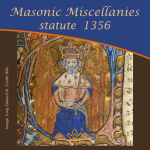 Masonic Miscellanies - statute 1356 Further to the reference in the article – The Builders - 6 - Free-Masons 'a statute was enacted against the Free-masons in 1356' – Regulations for masons who are hewers, on the one hand, and the light masons and setters on the other. |
 Masonic Miscellanies - An Anti-Masonic 'Apron'? The Anti-Masonic 'Apron' was created during the 1832 Presidential election in USA. It was not Ani-masonic. And it was not an apron. Read on to find out what and why it was created. |
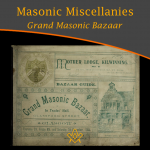 Masonic Miscellanies - Grand Masonic Bazaar (1895) Grand Masonic Bazaar (1895); to raise funds to clear the debt incurred by “Mother Kilwinning” in rebuilding their Lodge. |
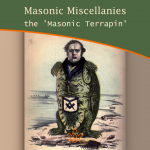 Masonic Miscellanies - the 'Masonic Terrapin' A satirical book from 1851 includes a bizarre caricature of a 'Masonic Terrapin' - all I can say is 'read on'… |
 Masonic Miscellanies - Masonic Bookplates You probably know what a bookplate is for, but did you know that the earliest known book mark/label dates from the reign of Amenhotep III in Egypt around 1391−1353 BCE?! |
 Masonic Miscellanies - Freemasonry & Bees Freemasonry & Bees - what's the buzz? The bee was among the Egyptians the symbol of an obedient people, because, says Horapollo, of all insects, the bee alone had a king. |
 Masonic Miscellanies - The mystery of the Tattooed Freemason In 1894, the body of a drowned man was found in the Bay of San Francisco - what they discovered was amazing. |
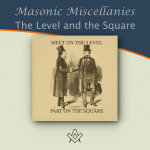 Masonic Miscellanies - The Level and the Square (A Poem) The Level and the Square (A Poem) - "We meet upon the Level, and we part upon the Square – |
 Masonic Miscellanies - The Mystic Tie What is the 'Mystic Tie'? Clue: it's not an item of neckwear! |
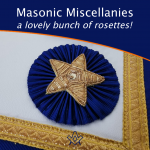 Masonic Miscellanies - A lovely bunch of rosettes! Where did the origin of the use of rosettes on Masonic aprons come from ? |
 Masonic Miscellanies - The Lodge of Sorrow The Lodge of Sorrow - Extracted General Ahiman Rezon, by Daniel Sickles, [1868] |
 Masonic Miscellanies - Memento Mori Memento Mori - a Masonic reminder to make your mark on the world |
 Masonic Miscellanies - A closer look at the Level and the Plumb-rule A closer look at the Level and the Plumb-rule |
 Masonic Miscellanies - The Symbolism of the Gloves The Symbolism of the Gloves and why Freemasons wear white gloves |
 Masonic Miscellanies - Will the real James Anderson please stand up? Will the real James Anderson please stand up? |
 Masonic Miscellanies - The Legend of the Third Degree The most important and significant of the legendary symbols of Freemasonry is, undoubtedly, that which relates to the fate of Hiram Abif. |
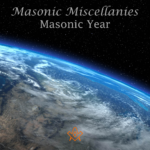 Masonic Miscellanies - Masonic Calendar Why do Freemasons use different 'years' to our regular calendar? |
 Masonic Miscellanies - What is a 'Lewis'? The English word 'Lewis' is a term belonging to operative Masonry, and signifies an iron cramp, which is inserted in a cavity prepared for the purpose in a large stone. |
 Masonic Miscellanies - From J.S.M. Ward Ever wondered why masons had to be 'free' or why we have a Tyler? |
masonic knowledge
to be a better citizen of the world
share the square with two brothers

click image to open email app on mobile device


